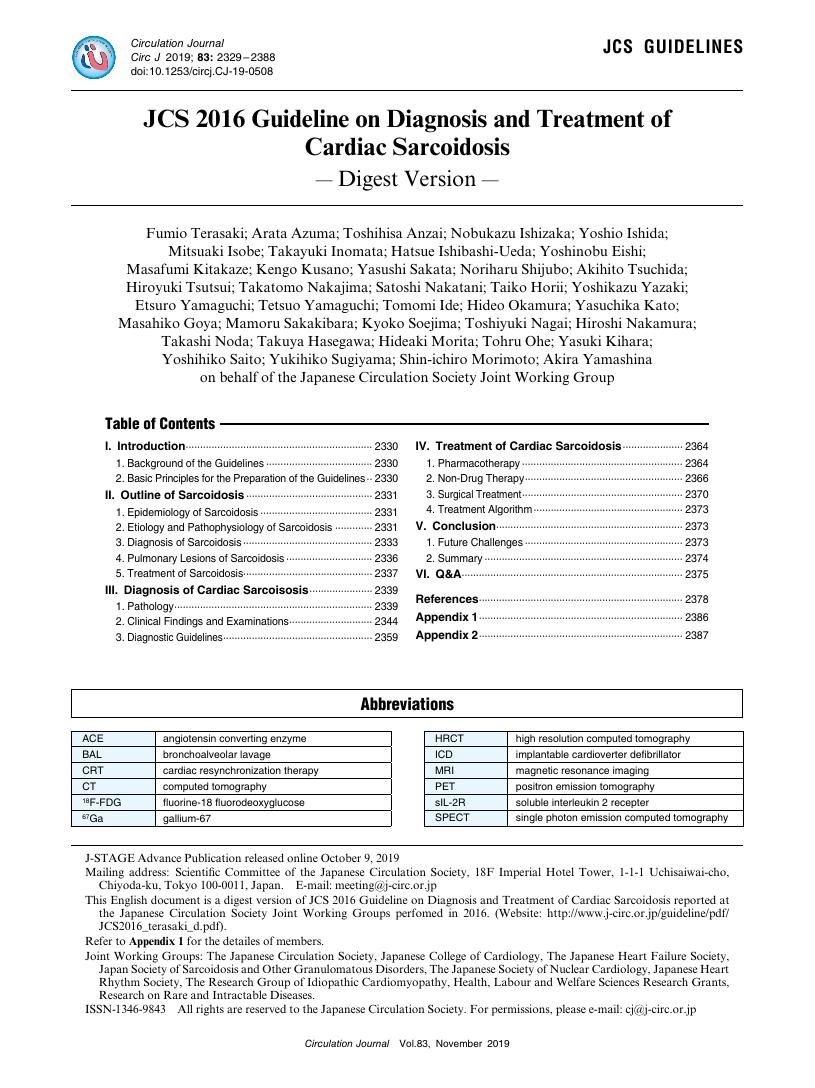- 著者
- Fumio Terasaki Arata Azuma Toshihisa Anzai Nobukazu Ishizaka Yoshio Ishida Mitsuaki Isobe Takayuki Inomata Hatsue Ishibashi-Ueda Yoshinobu Eishi Masafumi Kitakaze Kengo Kusano Yasushi Sakata Noriharu Shijubo Akihito Tsuchida Hiroyuki Tsutsui Takatomo Nakajima Satoshi Nakatani Taiko Horii Yoshikazu Yazaki Etsuro Yamaguchi Tetsuo Yamaguchi Tomomi Ide Hideo Okamura Yasuchika Kato Masahiko Goya Mamoru Sakakibara Kyoko Soejima Toshiyuki Nagai Hiroshi Nakamura Takashi Noda Takuya Hasegawa Hideaki Morita Tohru Ohe Yasuki Kihara Yoshihiko Saito Yukihiko Sugiyama Shin-ichiro Morimoto Akira Yamashina on behalf of the Japanese Circulation Society Joint Working Group
- 出版者
- The Japanese Circulation Society
- 雑誌
- Circulation Journal (ISSN:13469843)
- 巻号頁・発行日
- vol.83, no.11, pp.2329-2388, 2019-10-25 (Released:2019-10-25)
- 参考文献数
- 355
- 被引用文献数
- 95 243
2 0 0 0 OA Severe Pneumonitis with Alveolar Hemorrhage Associated with Herbal Medicines: A Case Report
- 著者
- Miwako Omori Yoshinobu Saito Yukiko Miura Toru Tanaka Takeru Kashiwada Kenichiro Atsumi Hiroki Hayashi Yuji Minegishi Kazue Fujita Arata Azuma Masahiro Seike Akihiko Gemma
- 出版者
- The Medical Association of Nippon Medical School
- 雑誌
- Journal of Nippon Medical School (ISSN:13454676)
- 巻号頁・発行日
- vol.86, no.5, pp.296-300, 2019-10-15 (Released:2019-12-03)
- 参考文献数
- 23
- 被引用文献数
- 1
We report a case of pneumonitis with alveolar hemorrhage induced by herbal medicines in a 73-year-old woman who was admitted to our hospital because of dyspnea and an abnormal shadow on a chest radiograph. She had received treatment with numerous drugs, including the herbal medicines Seisin-renshi-in, Chotosan, Rikkunshi-to, and Shakuyakukannzo-to. Chest radiography revealed diffuse ground-glass shadows in both lungs, and bronchoalveolar lavage fluid was progressively hemorrhagic. A culture of the fluid showed no evidence of microorganisms. Moreover, there were no findings suggestive of rheumatic disease or vasculitides. On the basis of this evidence, we suspected drug-induced diffuse alveolar hemorrhage. She discontinued all medicines and started treatment with corticosteroids. Her respiratory condition and chest radiographic findings improved. The timing of administration and rechallenge with other drugs suggested that the herbal medicines were the causative drugs. The primary concern was Seisin-renshi-in, because it contains Ougon (skullcap; a known cause of pneumonitis) and because a drug lymphocyte stimulation test was positive for Seisin-renshi-in. This is the first report indicating that Seisin-renshi-in may cause diffuse alveolar hemorrhage. Diffuse alveolar hemorrhage due to herbal medicines is a rare but emergent disorder. Therefore, treating physicians should be aware that it may be caused by herbal medicines, including Seisin-renshi-in.
- 著者
- Shinji Abe Arata Azuma Hiroshi Mukae Takashi Ogura Hiroyuki Taniguchi Masashi Bando Yukihiko Sugiyama
- 出版者
- 一般社団法人 日本内科学会
- 雑誌
- Internal Medicine (ISSN:09182918)
- 巻号頁・発行日
- vol.51, no.12, pp.1487-1491, 2012 (Released:2012-06-15)
- 参考文献数
- 21
- 被引用文献数
- 23 88
Objective The prognosis of idiopathic pulmonary fibrosis (IPF) patients with acute exacerbation (AE) is reported to be extremely poor. Several clinical studies suggest that direct hemoperfusion with polymyxin B-immobilized fiber (PMX) may have beneficial effects on AE in patients with interstitial pneumonia (IP). The aim of this multicenter retrospective analysis was to investigate whether PMX treatment could provide improvement of oxygenation and survival benefits in IPF patients with AE. Methods We conducted a retrospective study of 160 IP patients (including 73 IPF) with AE treated by PMX at 18 institutions in Japan. PMX treatment was carried out twice. The total hemoperfusion time of PMX treatment was, on average, 12 hours. Data concerning oxygenation on PMX treatment and survival after AE were collected and analyzed. Results In IPF patients with AE, arterial oxygen tension (PaO2)/inspiratory oxygen fraction (FiO2), (P/F) ratio was significantly improved at the end of the 2nd treatment with PMX (173.9±105.4 to 195.2±106.8 Torr, p=0.003). White blood cell count was significantly reduced at the end of the 2nd treatment (13,330±7,002 to 9,426±5,188 /mm3, p<0.001). These clinical changes were also observed on analysis of all 160 IP patients with AE. The one- and three-month survival rates of IPF patients after AE were 70.1% and 34.4%, respectively. Conclusion PMX treatment may improve oxygenation and survival in IPF patients with AE. Prospective, controlled trials of PMX treatment for IPF with AE are warranted to verify this potential benefit.
